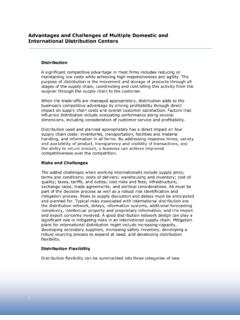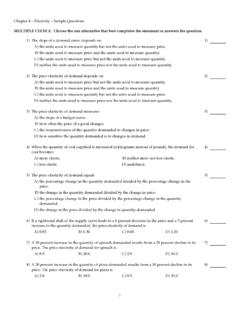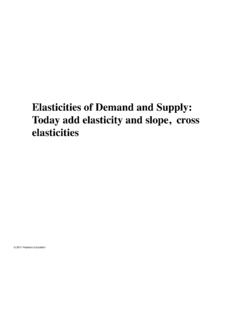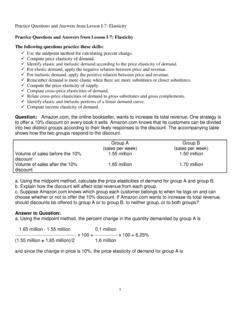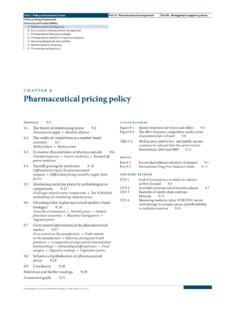Transcription of Supply, Demand, Equilibrium, and Elasticity
1 supply , demand , equilibrium , and Elasticity 1 The Meaning of supply supply describes the available goods and services in an economy. In a free-market economy like the United States, firms tend to be the economic agents producing goods and services for the general economy. supply describes the number and variety of goods and services available at any given time. Because all entities are scarce, which means that there are only so many things in the world, firms can supply only a limited amount of goods and services. The resources used to produce these goods are considered costs. The greater the use of resources, the higher the cost of a product will be. Firms try to produce and supply desirable goods and services. When firms are successful, they may be able to charge a higher price for a product than it costs to produce it.
2 When the revenue (or the money the firm receives for its product) exceeds costs, the firm is said to make a profit. The Law of supply The price of goods and services can change. Firms will respond to the changing prices by expanding or contracting the level of output. The law of supply explains how firms react because of changing prices When firms receive a lower price for a particular good or service, the firm will tend to reduce its output. Suppose a firm used to receive $10 for a good, but then the price changed to only $8. The firm is receiving $2 less per unit, so it will cut back on production and perhaps shift manufacturing resources to a more profitable type of good. When firms receive a higher price for a particular good or service, the firm will tend to increase its output. The firm will be making more money per unit, and this usually translates into higher profits.
3 The firm may then shift production resources to producing this more profitable product. Aside from a change in price, other factors can affect the overall supply situation for a good. These are called determinants of supply . Determinants of supply include components such as technology, the number of suppliers, and expectations of the future. If any one of these overarching determinants change, then any analysis based on the law of supply would have to be supply , demand , equilibrium , and Elasticity 2 recalculated based on this new change. The Meaning of demand demand describes which goods and services consumers desire and need. Individuals have basic needs like food, clothing, and shelter and will consistently demand them over time. Other goods and services may be considered nonessential or luxuries, and their demand can change more easily than the basic needs.
4 Individuals only have a certain amount of resources from which to purchase goods and services. This limitation on consumption is known as a budget. Given the wide variety of choices in the marketplace, consumers must prioritize their consumption based on their needs, desires, and financial constraints. When an individual manages to purchase a parcel of goods and services that provides the most useful list and satisfaction to him or her, he or she is said to maximize utility or happiness. Consumers generally have greater desires than what their budget can provide. The process of selecting the best parcel of goods and services is known as consumer choice theory. The Law of demand The price of goods and services can change. Consumers will respond to the changing prices by purchasing more or less of a particular good or service.
5 The law of demand explains how consumers react because of changing prices. When consumers go to the store and find a recently lowered price of a good they demand , they tend to increase their consumption of that good. For example, if grapes are on sale for $ a pound instead of the usual $ a pound, consumers may react by purchasing more grapes. At the recently lowered price, grapes will consume less of their household budget. When consumers go to the store and find an increased price of a good that they usually demand , they tend to decrease their consumption of it. Consumers have a limited budget, so they may be unwilling or unable to purchase the good at the higher price. Consumers demand less of that good. Aside from a change in price, other factors can affect the overall demand supply , demand , equilibrium , and Elasticity 3 situation for a good.
6 These are called determinants of demand . Determinants of demand include components such as consumers' incomes, tastes and preferences, and expectations of the future. If any one of these overarching determinants change, then any analysis based on the law of demand would have to be recalculated. The Role of Government In supply And demand In free-market economies like the United States, most production and consumption decisions are left to firms and individuals. The government does, however, exercise a large degree of control over the economy. The government is also a major purchaser of goods and services. The government can constrain or limit the ability to produce and consume goods and services through taxation policies. For example, if the government raises taxes on firms, the cost to produce goods will increase; likewise, if the government increases taxes on individuals, they will have a lower available budget and consequently can consume less.
7 The government can also boost the ability of consumption and production. The government can directly stimulate the economy by purchasing goods and services. The government also can provide tax cuts to stimulate the free market. Ceteris Paribus Ceteris paribus is a Latin phrase that means holding everything else constant. Economists use this assumption to help apply the laws of supply and demand . Many factors can influence supply and demand , and it is difficult to describe them all. With this limiting assumption, economists can isolate the effect of just a change in price on supply and demand . One criticism of economics is that it relies upon too many assumptions. Just based on everyday observations, it is easy to identify many factors that can influence supply and demand beyond price. Using the ceteris paribus assumption, however, economists can look at each of those factors in isolation.
8 More sophisticated economic models can be used to explain the interaction of many factors simultaneously. These models require a great deal of mathematical calculation, but they can yield particularly important supply , demand , equilibrium , and Elasticity 4 information for large consumer product corporations. The government also uses these types of models to help manage the economy. The Meaning of equilibrium equilibrium describes a state of balance. An everyday example of equilibrium is the use of a teeter-totter or seesaw. When two equally heavy children sit on each end of a teeter-totter, the plank balances in a form of equilibrium . In economics, equilibrium is an important concept because it describes when supply and demand are in balance. When consumers demand a certain amount of goods at a certain price and suppliers supply the same amount of goods at the same price, supply and demand are in equilibrium .
9 Over time, markets tend to adjust to an equilibrium level. equilibrium is a special state because consumers and producers exchange goods and services. When there is equilibrium , consumers and producers create a market for a particular good or service. Economists use models, or simplified abstractions, to explain how systems work. For example, a model train approximates how a commuter train runs. In economic models, mathematical tools are used to try and find the equilibrium level of a market. The models may be very complex. Government economists create and build complex models to try and explain equilibrium levels for the whole economy. There is no guarantee that a particular market will be formed for a good or service. The costs faced by producers may just be too high to satisfy the budgets of consumers. An obvious example would be a solid gold car.
10 Although such a car might be desirable, the cost of manufacturing it would be too high to create a market. Sometimes goods are said to be in shortage. This can happen when there is no or a very limited supply of a good or service. After a major snowstorm or weather event, there may be a shortage of fresh milk. Consumers may also not know about a good or service. Although a product may be excellently produced and priced well, consumers may not be aware of its existence. Hence, no market will be created for the good, and there will be no equilibrium . One of the functions of marketing is to inform consumers supply , demand , equilibrium , and Elasticity 5 about a good or service so that a market is created. Price Elasticity Price Elasticity is a measure that economists use to try to explain how much demand will change when there is a change in price.


